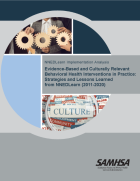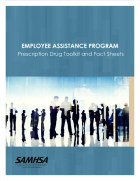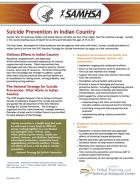This report provides findings from a qualitative analysis of evidence-based and culturally relevant behavioral health practices offered at NNEDLearn, a SAMHSA training, offered from 2011 to 2020. It includes an overview of NNEDLearn, case studies, strategies and lessons learned, and conclusion.
Dashboard: Filter Bricks
Main page content


Read key findings from the 2020 National Survey on Drug Use and Health (NSDUH) on substance use, mental health, and treatment by age group. Metrics in the report cover the civilian, noninstitutionalized US population ages 12 and older. Unlike other NSDUH Annual National Reports, the 2020 report has no comparisons to the previous year, because changes in survey methodology mean the indicators are not comparable to past NSDUH estimates.

The EAP Prescription Drug Toolkit and Fact Sheets provide guidance related to counseling, referrals, and follow-up services (e.g., alternatives to prescription drugs, workplace drug misuse and relapse prevention, dangers of combined drug use, screenings, and evaluations before returning to work).

The book is composed of SAMHSA’s “National Guidelines for Behavioral Health Crisis Care: Best Practice Toolkit” and related papers on crisis services. The toolkit reflects relevant clinical and health services research, review of top national program practices and replicable approaches that support best practice implementation. The related papers address key issues relevant to crisis services, homelessness, technology advances, substance use, legal issues impacting crisis services, financing crisis care, diverse populations, children and adolescents, rural and frontier areas, and the role of law enforcement.

This updated manual contains a 12-week cognitive–behavioral anger management group treatment model. The content includes specific instructions and suggested remarks for group leaders, and exercises for group members. This model will work in a variety of clinical settings, and with diverse audiences.

Este kit de herramientas ayuda a los centros para personas mayores a integrar la prevención del suicidio en actividades que apoyan el bienestar. Describe actividades que aumentan los factores de protección y explica cómo reconocer las señales de alerta del suicidio.

This quick guide contains an overview of the challenges associated with tobacco cessation and the benefits of being tobacco-free for individuals as well as those of a smoke-free workplace. It also includes tips that substance use disorder treatment settings can use to implement their own tobacco cessation programs.

Entendamos el trauma infantil
This infographic is a Spanish language version of information for the general public on the prevalence and impact of traumatic events on children, and what actions can be taken to support children who experience traumatic events.

This report highlights existing programs that address behavioral health disparities among Asian American, Native Hawaiian, and Pacific Islander boys and young men. It also outlines effective tools and best practices in working with this population.

This fact sheet, developed for tribal audiences and the agencies that work with them, reviews suicide prevention in Indian Country and how the 2012 National Strategy for Suicide Prevention can apply to tribal communities.
Displaying 1 - 10 out of 45

